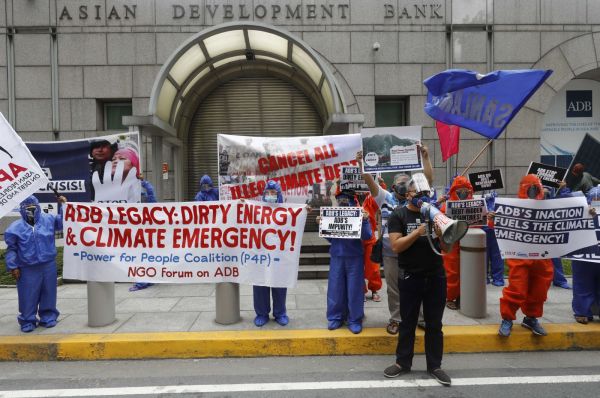Philippines LNG facilities are risky play for investors: report
By Janice Heng

Climate protestors in Manila call on the Asian Development Bank (ADB) to stop funding fossil fuel energy projects. Exporting countries have held up liquified natural gas as a viable transition fuel from coal to renewables.PHOTO: EPA-EFE/Rolex Dela Pena
Though the Philippines may seem to be rushing to develop liquified natural gas (LNG) facilities, investors in such infrastructure should beware of risks such as regulatory and financial uncertainty, the Institute for Energy Economics and Financial Analysis (IEEFA) said in a new report.
With officials having endorsed a rapid buildout of LNG import infrastructure, and exporting countries and industry players having held up LNG as a viable transition fuel from coal to renewables, it is easy to assume that the Philippines’ LNG demand will grow rapidly “and that investments in LNG-fired power plants will face negligible development risks and reap all-but-guaranteed returns”, said IEEFA energy finance analyst Sam Reynolds, the report’s author.
But that is not necessarily the case, with the Philippines having a long history of incomplete LNG import projects, he added.
He estimates the total value of proposed LNG import infrastructure – including power plants, ports, regasification facilities, and pipelines – at US$13.6 billion, “all of which is at risk of being stranded due to the rapidly changing legal and commercial landscape”.
The report highlights several obstacles for LNG-to-power investors, including nascent legal and regulatory regimes; rapidly changing power market structures; a lack of existing transmission and distribution infrastructure; and plummeting renewable energy price trajectories.
First, while policymakers have been addressing lower-level administrative hurdles, higher-level legal and regulatory regimes for LNG are still in the nascent stages and could take years to implement.
Second, there are no available government-backed power purchase agreements or guarantees, leaving investors in LNG-fired power plants exposed to market risks arising from changes in the commercial and regulatory landscape.
Third, there is no existing transmission and distribution infrastructure to supply non-power consumers. If LNG is to be used in industrial, commercial, residential, and transport sectors, this will require massive investment in gas transportation infrastructure, said the report.
“Therefore, LNG demand is likely to undershoot analyst forecasts for rapid growth, leaving investors on the hook for unused mid- and downstream capacity,” said the report.
Fourth, the rise of renewable energy will cause LNG to become increasingly uncompetitive.
“As renewables prices continue to drop and global LNG markets tighten to increase fuel costs, LNG-related investments will become increasingly uncompetitive in the Philippines market, especially as smaller electricity consumers become eligible to choose their retail suppliers,” said Mr Reynolds.
Source: ASEAN Business
